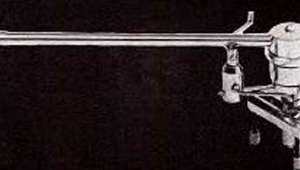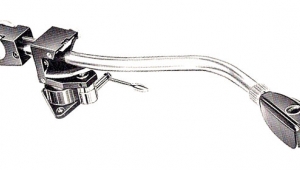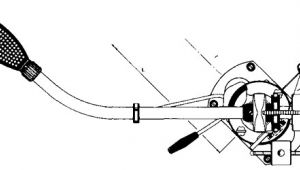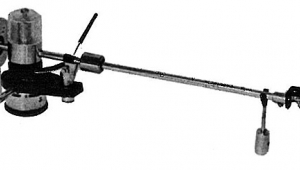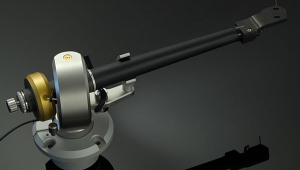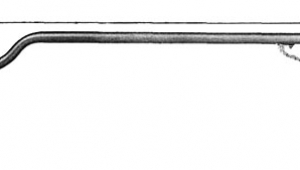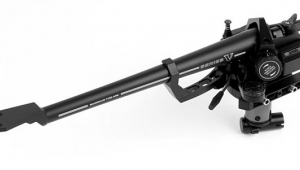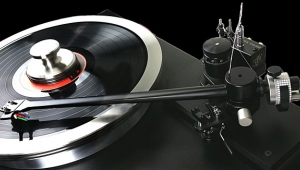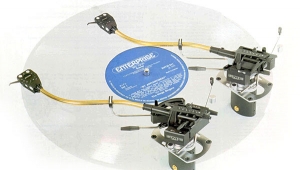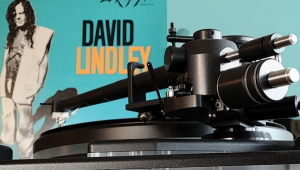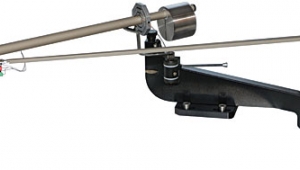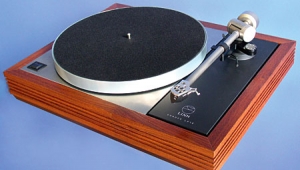| Columns Retired Columns & Blogs |
Graham Model 1.5 tonearm Follow-up, the 1.5-T/C
Sidebar 3: Follow-up, the 1.5-T/C
Footnote 1: Prices: $2350 for original 1.5 with brass side weights and standard SW-2 armtube; $2750 for 1.5-T with tungsten side weights, SW-2 armtube, and AZ-1 azimuth device; $2900 for 1.5-T/C with tungsten side weights, SW-3 armtube, and AZ-1 azimuth device. All prices include stylus gauge and tool kit.—Steven Stone
Steven Stone commented on the Graham 1.5-T/C in June 1995 (Vol.18 No.6):
Writing, Ernest Hemingway noted, is the art of beating dead men at their own game. Writing Stereophile Follow-Ups is the art of bettering fellow reviewers at their game without seeming impertinent. Dick Olsher reviewed the Graham Model 1.5 tonearm in Vol.14 No.3, and Tom Norton reviewed it in passing in Vol.14 No.8 and Vol.15 No.4. What more could I say about the bloody thing? Nothing, if Bob Graham could leave his arm well enough alone. In the last year, Graham has made some changes to his "baby" that deserve to be brought to the attention of Stereophile readers.
Revisions:
The Graham arm ($2350-$2900, depending on options, footnote 1) is a unipivot design, meaning it has just one pivot point (downward-pointing in this case), which allows it to move freely in both horizontal and vertical planes. Unipivot tonearms have been around since the dawn of audio time (footnote 2), but the Graham's design is, I feel, the finest realization of the unipivot's ultimate potential. In his review, Dick Olsher presents a textbook overview of the primary problems of tonearm design. After you peruse that review, you'll know enough about the two different systems of cartridge overhang geometry and the arguments for each to choke a horse. Suffice to say that the Graham arm is the only arm I know of that permits the user to easily employ either system.
The Graham's other outstanding features include interchangeable "wands," and a foolproof cartridge-alignment system that permits users to change cartridges in a matter of moments.
Changes to the original Graham 1.5 arm since DO's review include the option of T-2 tungsten steel weights to replace the standard brass weights ($250), hence the appellation 1.5-T. The internal wiring material has also been changed from multistrand copper to single-conductor silver. The counterweight design has been slightly altered by changing the surface area and rigidity of the counterweight coupling material.
Originally, the arm was available either without cable, or with a termination box, the IC-2 (sold separately for $150), which had an SME-type hookup on one end that connected to a box with standard RCA females protruding from it. That box is now available in a deluxe version, the IC-2.5 ($250), which has WBT RCA terminations. There's also a special "direct silver cable" IC-30 ($500), which is made with the same mono-crystal silver wire as that found inside the arm. The IC-30 is 1m long, and has a DIN 5-pin connector on one end, and your choice of RCA or XLR connectors on the other.
Fitted with the tungsten steel weights and the new high-tech SW-3 ceramic armtube, the original Graham 1.5 is transformed into the 1.5-T/C. Like the Rega RB-300, the SW-3's armtube is a progressional casting so that the inner-wall thickness varies to break up resonances. Even the "standard" SW-2 armtube has undergone minor changes, and now has a thicker headshell than the original. Both the SW-2 and the SW-3 have internal shielding all the way to the headshell and internal constrained-layer damping. Both also continue the signal grounding through the armtube via a Litz wire that circumvents the pivot to provide continuous shielding all the way back to the phono preamp. Additional SW-2 armtubes cost $500 each; SW-3 ceramic armtubes cost $650.
Setup & System
Rather than repeat the setup procedure DO described in his original review, I'll just comment on the ease of the Graham's setup compared to other arms I've reviewed. The Graham is simply the easiest arm in the audiophile universe to set up. Even someone as hamfisted and mechanically disadvantaged as I am can set up and mount a cartridge on a Graham with the precision of a brain surgeon. If you're the sort of audiophile who obsesses over setup, the Graham arm will pay for itself in unused therapy hours.
Analog components included a VPI TNT Jr. turntable with Power Line Conditioner, tripod pulley system, and outboard flywheel on a Bright Star base and Townshend Seismic Sink. Cartridges included a van den Hul MC-1 Super, Dynavector XX-1L low-output MC, Benz L04, Fidelity Research/van den Hul FR-1 Mk.III, and Denon S-1.
Phono preamps were the Vendetta SCP-2C, Naim Prefix MC with Hi-Cap supply, and Michael Yee PFE-1. Line-level preamps used included the Threshold T-2, Pass Aleph P, Audio Research LS5, and Boulder L5-AE. Power amps used included the Boulder 250-AE and 500-AEs. Speakers were the Apogee Acoustics Full-Ranges with a Bryston 10B electronic crossover. Interconnects included AudioQuest Diamond, Esoteric Artus, and WireWorld Eclipse, the last two in both balanced and single-ended terminations. Speaker cables used were 8' lengths of Dunlavy Labs DLZ-8. Accessories included Turtle Moon, by Alice Hoffman.
Sound
For those readers who already own Graham tonearms and who may be interested in making incremental upgrades, I'll describe what effect each change has on the sound of the "original" Graham arm as reviewed by DO. I have one of the first Graham arms ever made, and recently had it rebuilt to current specifications (footnote 3). While I don't think a total rebuild is de rigueur, most of the field-alterable upgrades do seem to be well worth the added investment.
For the following sonic comparisons, I used the Dynavector XX-1L cartridge almost exclusively because, of all the standard-mount carts I had on hand, the Dynavector was simply the best all-around sonic performer. It has more low-end weight and a slightly richer midrange than the van den Hul MC-1, and a sweeter top end and a more natural upper midrange than the Benz L04. The Dynavector is much faster, with better transient detail, than the Fidelity Research/van den Hul FR-1 Mk.III, and has a more natural midrange and better bass extension than the Denon S-1.
I've had the XX-1L cart for about nine months, and have used it on both the Graham and the Wheaton Triplanar IV Ultimate arms with excellent results. The medium-mass XX-1L weighs in at 12 grams, and has a Microridge-type stylus, a solid boron cantilever, and a built-in "flux-damping" feature. I listened with the flux-damping feature turned both on and off and couldn't hear any difference between the two, so I turned it off via the small switch on the front of the cart.
Footnote 1: Prices: $2350 for original 1.5 with brass side weights and standard SW-2 armtube; $2750 for 1.5-T with tungsten side weights, SW-2 armtube, and AZ-1 azimuth device; $2900 for 1.5-T/C with tungsten side weights, SW-3 armtube, and AZ-1 azimuth device. All prices include stylus gauge and tool kit.—Steven Stone
Footnote 2: Old-timers will remember the Gray 108 series unipivot (which was the first viscous-damped tonearm); the Pickering flux-valve cartridge arm (a real dog, according to JGH); the Mayware Formula 4 arm (which was also viscous-damped); the Decca International arm (again viscous damped); and the Ultracraft 5000 (which also had interchangeable wands). I know I've left a few classic unipivots out, but these are the ones that immediately come to mind.—Steven Stone
Footnote 3: This rebuild wasn't intentional on my part. When I shipped the arm back to Bob Graham for upgrading, I neglected to remove the damping fluid. Silicone went everywhere, and complete disassembly was required to remove it all. Bob updated the entire arm while it was apart.—Steven Stone
- Log in or register to post comments
